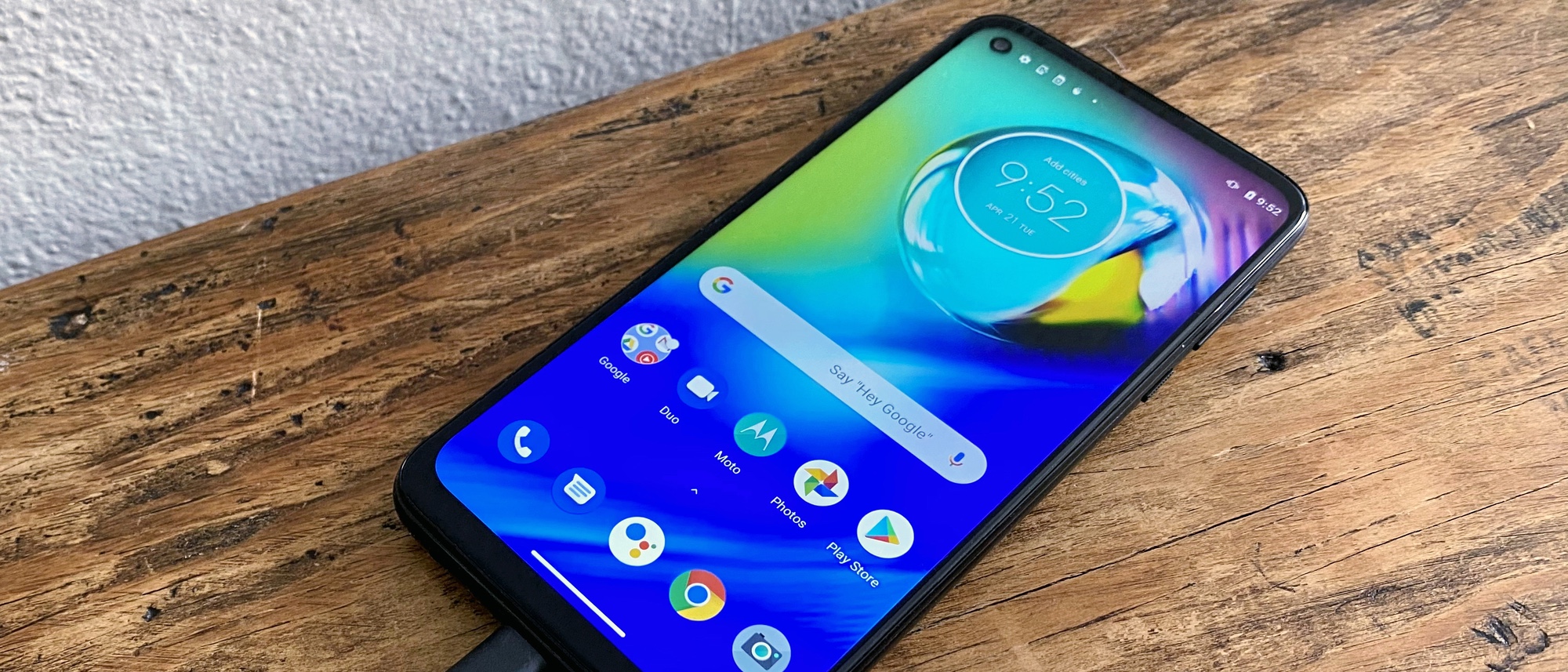Tom's Guide Verdict
The Moto G Power lasts even longer than its record-setting predecessor while costing the same amount. This is the budget phone to buy if you want great battery life — unless you get the newer Moto G Power (2021) instead.
Pros
- +
The best battery life we’ve tested
- +
Low price tag
- +
Decent performance and photos for the price
- +
Works on all networks
Cons
- -
Screen isn’t very colorful
- -
No optical zoom
Why you can trust Tom's Guide
Editors' Note: This review looks at the Moto G Power released by Motorola in 2020. The phone maker has since come out with a new version, the Moto G Power (2021), that features the long-lasting battery and price, in addition to a sub-$200 version. Read our Moto G Power (2021) review to see how that new phone measures up to this model.
The Moto G Power that came out in 2020 had a tough act to follow. Its predecessor, the Moto G7 Power, was a bargain hunter's dream phone, delivering the best battery life of any mobile device while only costing $249. That's a package that should get anyone's attention, so it's no wonder the Moto G7 Power had been a mainstay on our list of the best cheap phones.
Starting price: $249
OS: Android 10
Screen size (Resolution): 6.4-inch LCD (2300 x 1080)
CPU: Snapdragon 665
RAM: 4GB
Storage: 64GB
Expandable: Yes, up to 512GB
Rear Cameras: 16MP main (f/1.7), 8MP ultra wide angle (f/2.2), 2MP macro (f/2.2)
Front Camera: 16MP (f/2.0)
Battery Size: 5,000 mAh
Battery Life (Hrs:Mins): 16:10
Size: 6.3 x 3 x 0.38 inches
Weight: 7 ounces
For the 2020 model, Motorola didn't change those two key features. The Moto G Power still has the 5,000-mAh battery that helped the previous version of this phone outlast the competition. And at the time of its launch, you could get the Moto G Power for the same $249 price as before.
- Best unlocked phones
- Here are the best Android phones
If you hate paying big bucks for your smartphones, you really should consider the Moto G Power, even when taking budget options from Apple, Google and OnePlus into consideration. While battery life remains the main selling point here, our Moto G Power review found enough additional benefits like solid performance and good-for-their-price cameras that make this phone even more of a steal than it was before. About the only reason not to consider this model is that there's a newer version — the Moto G Power (2021) — which also lasts a long time on a charger and comes in a cheaper version.
Moto G Power review: Price and availability
Even with the newer Moto G Power (2021) available, you can still find the 2020 edition of the Moto G Power at retailers and carriers. Google Fi, for example, continues to sell this version of the Moto G Power, though at a substantial discount from its regular price of $249. You can also buy the phone unlocked from Motorola, and retailers including Amazon, Best Buy and B&H Photo.
If you do opt for the 2020 edition of the Moto G Power, make sure you're getting it at a discounted price. Not only does the Moto G Power (2021) have the same $249 price as this phone, you can also find a $199 version of the newer model that features less RAM.
Moto G Power review: Design
You will not mistake last year's Moto G Power for a flagship device, particularly when you pick up the phone. It's not that Motorola's phone looks bad — it's just that the G Power uses a plastic chassis and there's not a lot you can do to disguise that. Motorola has given this phone a glossy finish on the back, which adds some polish to the phone's looks.
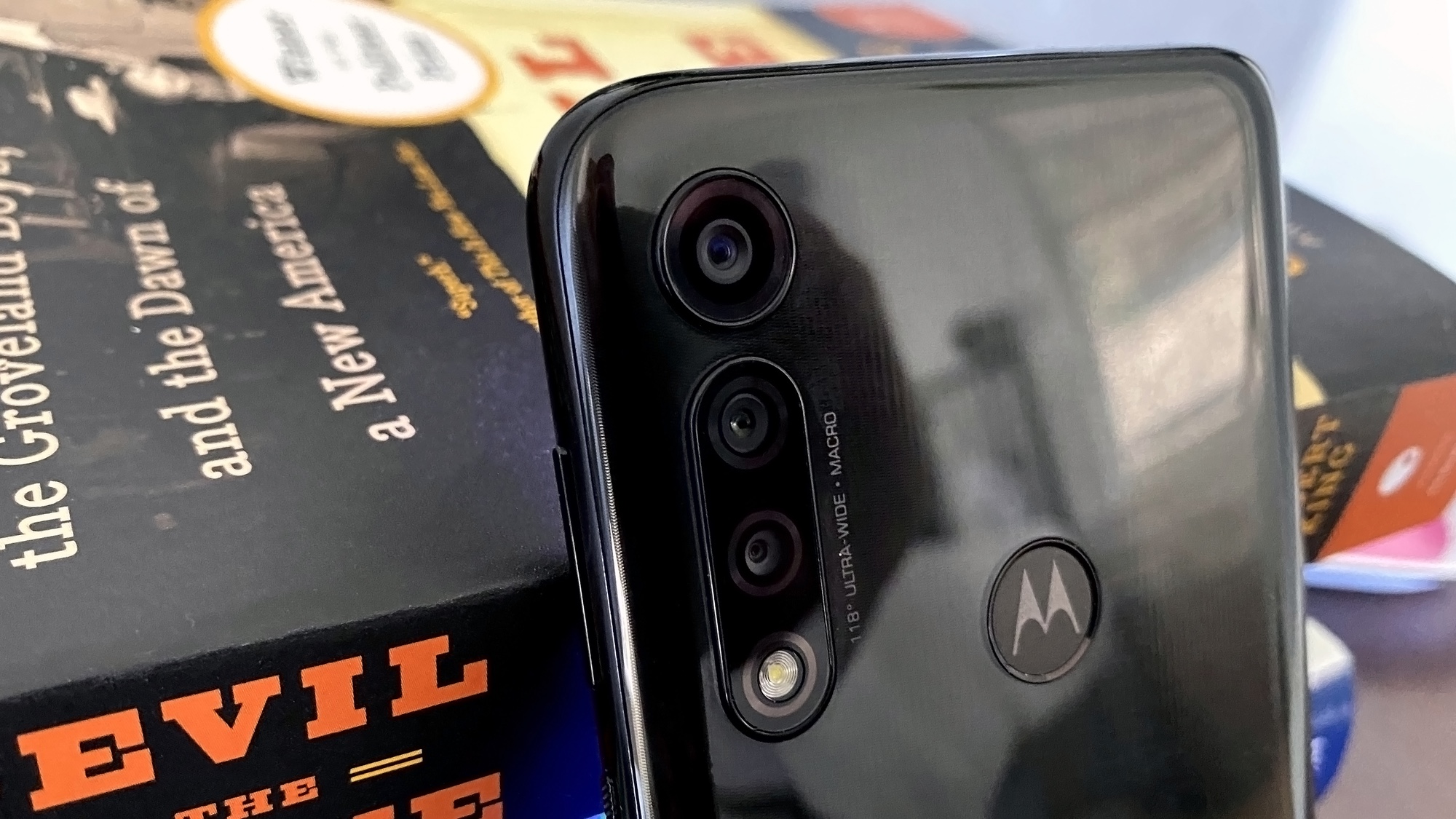
If you dislike the trend toward big, blocky camera arrays, you'll appreciate how the Moto G Power handles its trio of rear lenses. They descend vertically down the left side of the phone with the main shooter all by itself. The ultra wide angle and macro lenses are in a separate bump along with the phone's flash. That leaves space in the center of the phone for an easy-to-find fingerprint sensor.
As for the front camera, Motorola has placed it inside a punch-hole cutout in the upper left corner of the phone's 6.4-inch display. That has allowed Motorola to shrink the Moto G Power's bezels, though they haven't gone away completely, particularly on the bottom of the screen.
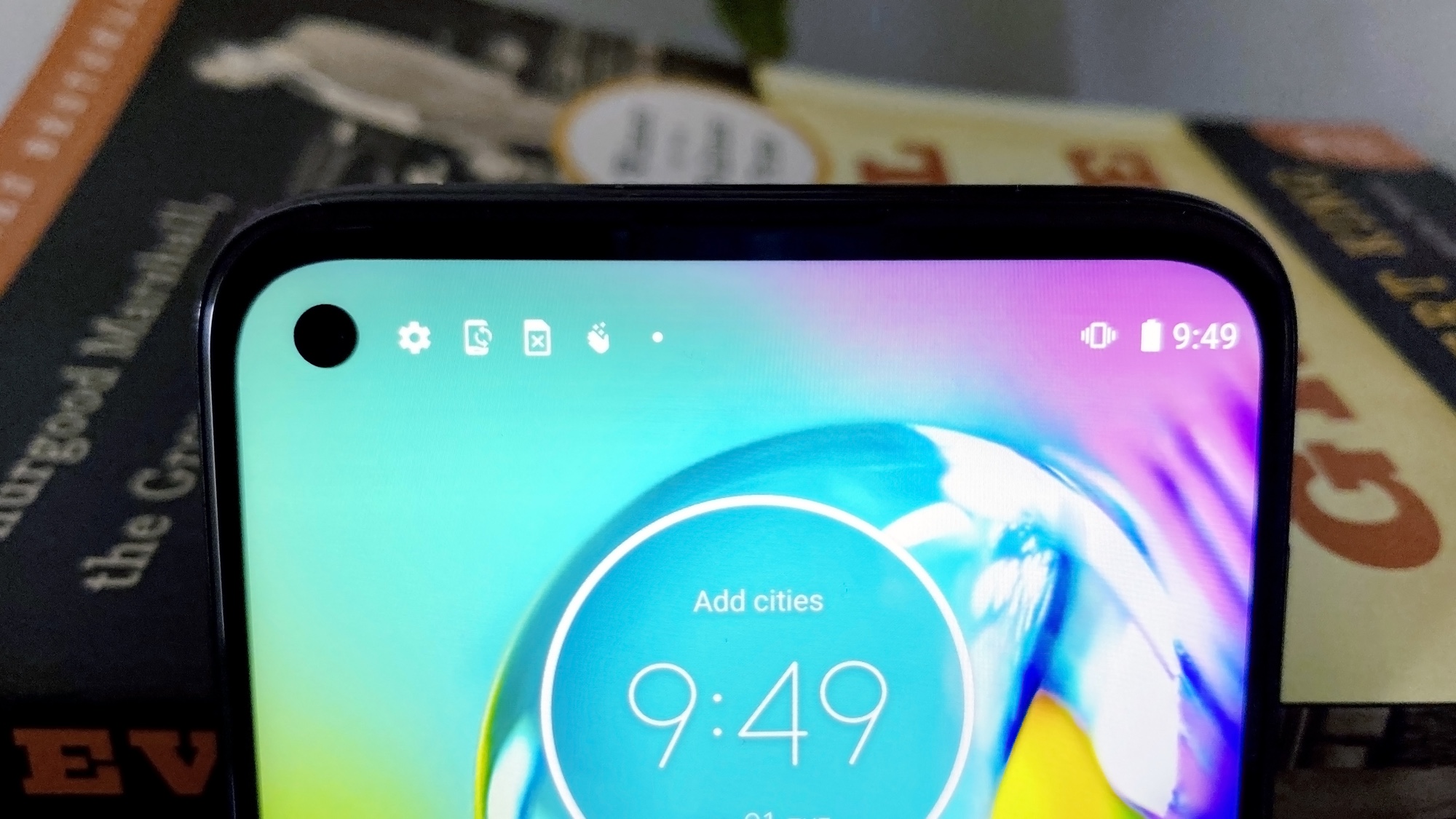
The 5,000 mAh battery that serves as the Moto G Power's calling card also makes this a chunky phone. The G Power measures 6.3 x 3 x 0.38 inches, making it larger than the 5.7 x 2.7 x 0.3-inch Pixel 4a, particularly when it comes to thickness. At 7 ounces, the Moto G Power is relatively weighty, too, outweighing both the Pixel 4a (5.04 ounces) and Nokia 7.2 (6.35 ounces).
You'll get a 3.5mm headphone jack on the Moto G Power, an increasingly rare but still welcome sight. Motorola says the phone is "water repellant," but there's no IP rating. I'd guess that light spray and the odd sprinkle will likely pose no threat, but don't drop this phone in the pool.
Moto G Power review: Display
If there's one area where the Moto G Power really comes across as a budget phone, it's the phone's display. Motorola uses an LCD panel, which you'd expect in a sub-$300 phone. The 6.4-inch screen features Full HD+ resolution, which again is pretty standard on a phone of this kind.

My issue with the Moto G Power screen is that colors don’t look vibrant on the phone's display. Watching the No Time to Die trailer on the Moto G Power, scenes looked particularly shadowy, even when brightly lit. A close-up on Daniel Craig's face looked especially dark on the Moto G Power's screen, when it appeared better lit on other phones I've been using lately. Similarly, some older clips from Conan O'Brien's show looked a little blown out on the Moto G Power's display.
Our lab testing backed up my hands-on impressions. The phone showcases just 97% of the sRGB color spectrum in its default setting (which, ironically, is the saturated mode). That's consistent with other phones in the latest Moto G series, including the Moto G Fast (97%) and Moto G Stylus (98%). To put that in perspective, the Nokia 7.2, another LCD-equipped budget phone, managed to capture 153% of the colors.
At least the colors on the Moto G Power are fairly accurate, given its Delta-E rating of 0.33. (The closer the number is to zero, the better.) That's about what last year's Moto G7 Power (0.35) was able to deliver.
While the colors on the Moto G Power screen didn't impress me, the display's brightness was more than satisfactory. We measured brightness at 500 nits for the Moto G Power, just ahead of the average for smartphones. Both the Pixel 4a and iPhone SE are brighter, at 681 nits and 653 nits respectively, but when using the Moto G Power outside, I never had to crank up the display to maximum brightness just to see the screen.
Moto G Power review: Cameras
Go back to just a few years ago when putting more than one camera on a budget phone was unthinkable. These days, Motorola has stuck three lenses on the back of the Moto G Power. And while they're not going to produce photos that surpass what you can get from the latest iPhone 12 and Pixel 5 models, the Moto G Power cameras hold their own against the best budget shooters — so much so, that we included the Moto G Power among the best camera phones at one point. It's hard to find a better camera on a phone that costs less than $300, though the Moto G Power (2021) tries with a more powerful main lens.
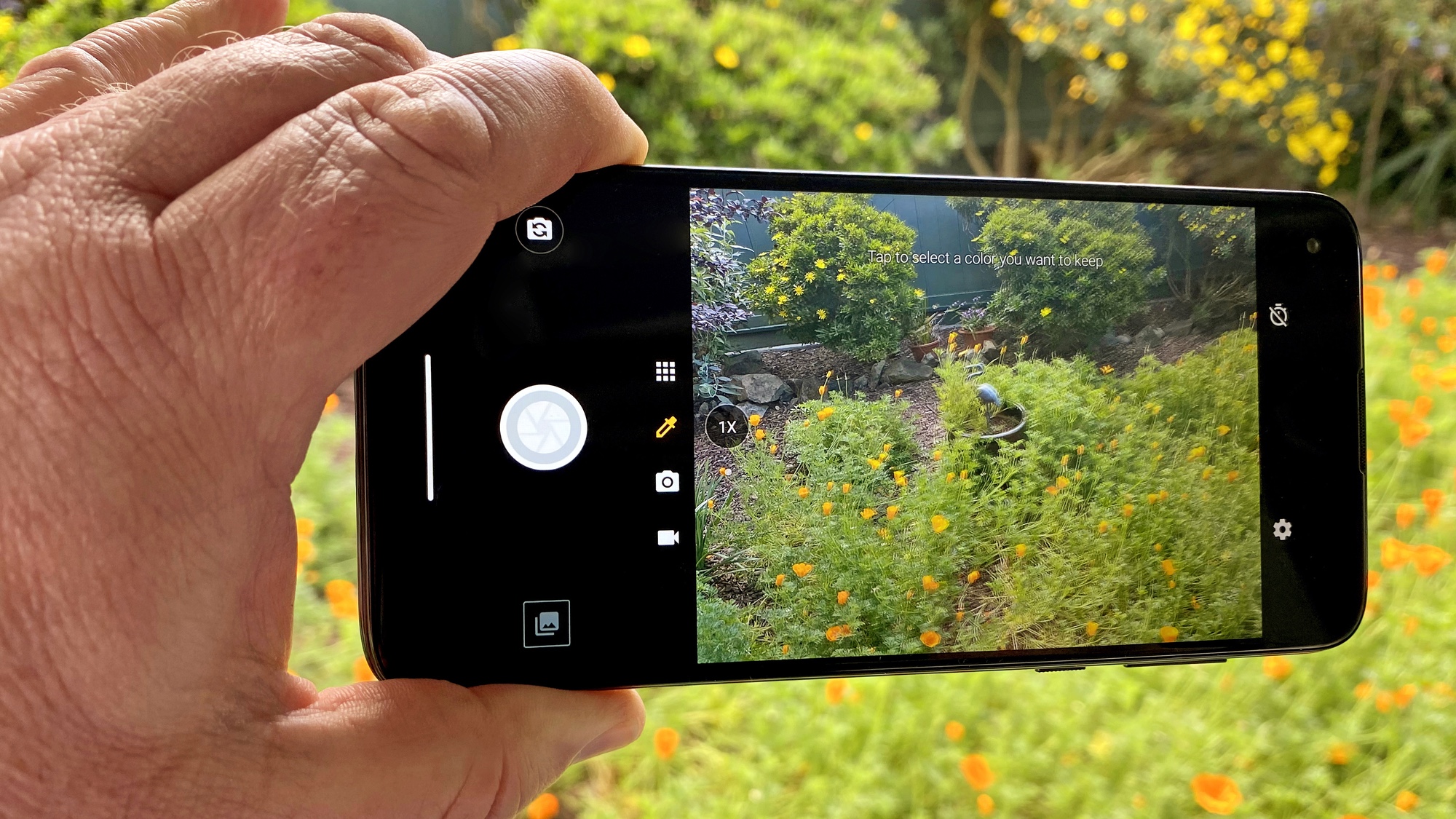
The main camera on the back of the older Moto G Power is a 16-megapixel camera with an f/1.7 aperture. That's augmented by an 8MP ultra wide angle shooter with a 118-degree field of view plus a 2MP macro camera. The lack of a telephoto lens on the Moto G Power means that any zooming in you do will be digital and likely not as sharp as what an optical zoom can produce.
So how do the Moto G Power's cameras fare in real-world testing? To find out, I pitted the new Moto phone against a Pixel 3a XL. The Pixel 4a hadn't come out yet when we tested this phone, and Google's 3a lineup boasted the best budget camera phones we had tested in the past year.
In the case of this photo of some California poppies that have sprung up in my backyard, it's clear the more expensive Pixel 3a XL takes the better shot. It's better able to contend with the shadow cast over my yard, keeping the flowers in the background as focused as the ones in the forefront. The Moto G Power's image is brighter, but the flower petals aren't as sharp and the shot doesn't seem as balanced as what Google's phone produced.

Switching to the macro lens on the Moto G Power, we see the benefits of that dedicated camera. I could get up close to one of the poppies and get a fairly detailed shot, with noticeable patterns on the flower's petals. The edges of those petals are a little jagged, though, so it's not quite the perfect pic.
Moving inside to take a picture of dinner, the Moto G Power gets the better of the Pixel 3a XL in terms of color. Google's phone struggled with the light coming in from my dining room window, and as a result, the photo has a bluish cast, which is particularly evident on that buttered bread in the background. The Moto G Power's photo is brighter, and the colors more true to life, though some of the pieces of sausage and the dab of mustard aren't kept in focus. Even with its less pleasing color, the Pixel's shot is in focus and more detailed.
Neither the Moto G Power or Pixel 3a has a dedicated telephoto lens for optical zooms, but I wanted to see how the software on both phones dealt with a zoomed-in shot of a Coast Guard boat docked across the channel from where I live. (I approximated a 3x zoom on both phones, as there's no number readout on the Google phone as you zoom in.)
The Pixel 3a XL continues to bathe everything in a blue light, which affects everything from the white boat to the gray clouds. The Moto G Power produces more realistic colors, but the letters and numbers on the side of the boat aren't as sharp. Score a win for the Super Res Zoom feature on Google's Pixel phones.

One thing the Moto G Power can do that Google's Pixel 3a lineup can't, though, is zoom out. I switched to the ultra wide angle on the Motorola phone to capture more of the surrounding landscape around the Coast Guard ship. The result is an impressive skyscape, though the objects in the far background — like the ship itself — have lost focus.
The Moto G Power is at a disadvantage when the lights go down, as it lacks a dedicated Night mode. (You will find that feature on the Moto G Stylus, the G Power's slightly pricier sibling.) A photo of an after-hours stuffed animal party in my backyard illustrates just what you're giving up by foregoing a budget phone capable of nighttime photography.
The Pixel 3a XL keeps the atmospheric red lighting of the scene while balancing the white lamp in the background and keeping all the stuffies in focus. The Moto G Power manages to capture some of the scene, thanks to the ambient lighting, but it's not terribly detailed and too murky. (I also took a shot using the Moto G Power's flash, which produced a much clearer shot, although all the lighting effects were wiped out.)
I'm not impressed by the Moto G Power's take on portrait shots. The bokeh in this photo of my daughter seems haphazardly applied, with the upper left corner of the bottlebrush bush behind her not even blurred. You're able to adjust the blur and lighting effects to several different presets on the Moto G Power, but I suspect most users would just prefer to let the computational photography do the work for them. That certainly happens on the Pixel 3a XL, which also cuts in closer for its portrait shots.
It's a similar story on selfies where the background blur on the Moto G Power isn't as polished as what you'll see from other phones. That said, the warmer colors on the Moto G Plus' selfie are more pleasing and accurate, even if the Pixel 3a XL did a better job preventing some sunlight off to the right from blowing out parts of my shirt.

Some special features found in other Motorola phones make a return appearance on the Moto G Power. Spot Color uses on-board AI to filter out all but one color of a shot. The effect can be quite striking in some photos, like this picture of yellow and orange flowers where only the yellow remains. But I had my best luck using the feature with two contrasting colors — a photo of pink and purple flowers only flummoxed the Moto G Power.

The Moto G Power also supports a Cinemagraph feature that lets you specify certain areas of a still shot that can include movement — essentially turning your photos into a GIF. I was pretty impressed by this photo where my wife is pouring a glass of wine — and you can see the wine pouring — at least until I noticed the vase in the background was also pulsing. Exactly what was in that wine?
Moto G Power review: Performance
You don't buy a phone like the 2020 Moto G Power expecting a workhorse, but the Snapdragon 665 system-on-chip powering the phone should be more than enough to handle typical tasks. Motorola also includes 4GB of memory to help keep things peppy, though there’s only 64GB of storage. Need any more, and you have to turn to a microUSB card.
On Geekbench 5, which measures overall performance, the Moto G Power turned in a multicore score of 1,387. That's better than the 1,336 result produced by the Pixel 3a and its Snapdragon 670 processor, but not as good as the 1,498 result that we got from the Snapdragon 660-powered Nokia 7.2. For what it's worth, the newer Moto G Power with its Snapdragon 662 chipset, turned in a slightly better number than its predecessor with a 1,437 result in Geekbench.
Both of the Nokia and Pixel phones outpaced the 2020 Moto G Power when it came time to test graphics using 3DMark's Sling Shot OpenGL test. The Moto G Power recorded an average score of 1,734, well behind the respective 2,054 and 2,543 results produced by the Nokia 7.2 and Pixel 3a.
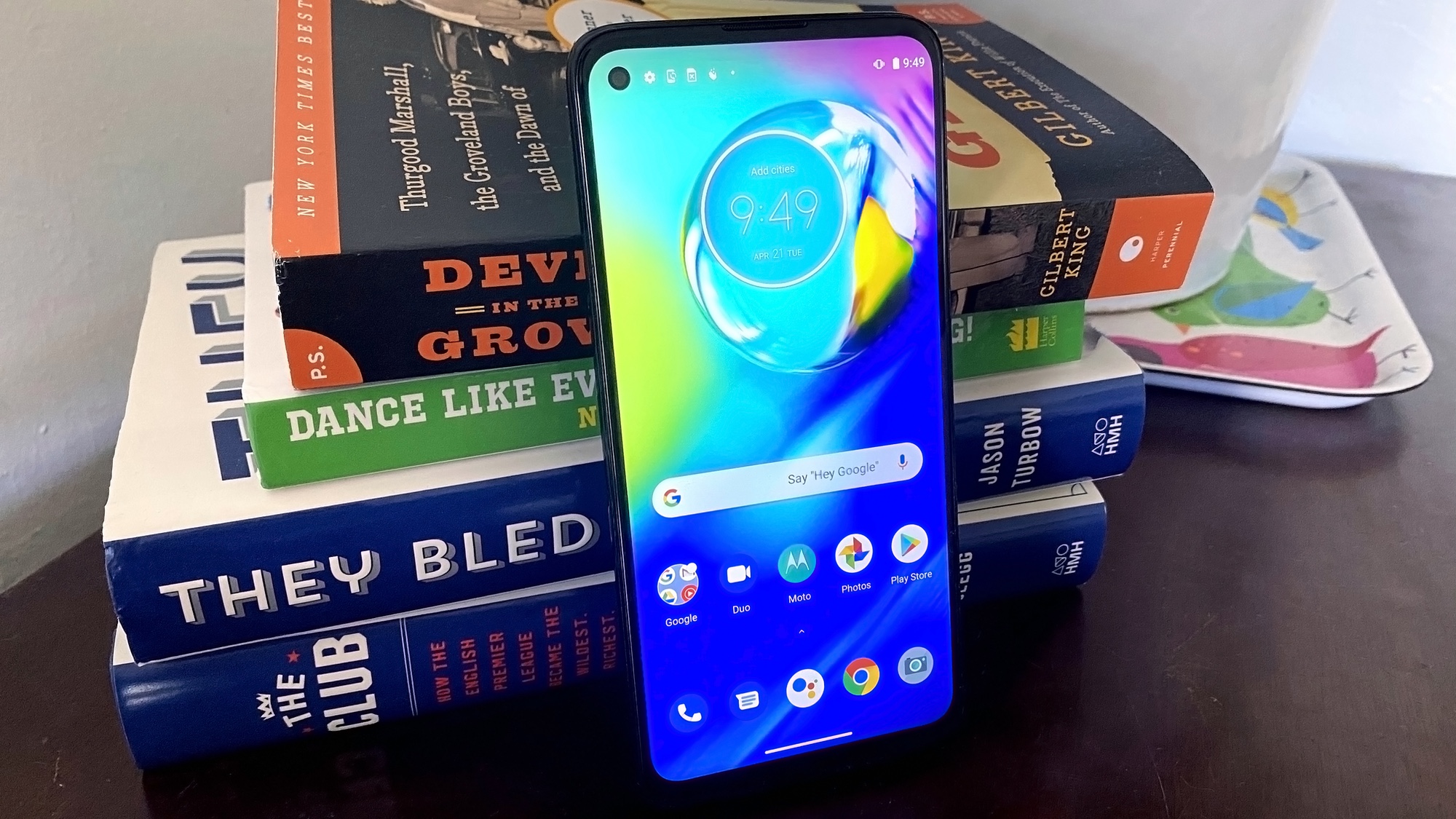
That said, I didn't run into any problems when using the Moto G Power to switch between apps, browse the web and do other basic tasks you'd expect a smartphone to handle. Even the demanding PUBG Mobile shooter played alright on the Moto G Power, despite a few choppy moments here and there. You'll find better performing phones than the Moto G Power, but they'll require you to pay up for the gain in performance.
Moto G Power review: Battery life and charging
This is a new high score. Thanks to its 5,000 mAh battery, the Moto G Power lasted an epic 16 hours and 10 minutes on our web surfing battery test. That beats the Moto G7 Power by more than half-an-hour. Even the newer Moto G Power (2021) falls behind its predecessor (though that phone's 14-hour plus result is the second best result of currently available smartphones).
Last year's Moto G Stylus — a phone with the same screen size and processor as the G Power but with a smaller 4,000 mAh battery — lasted 12 hours, 13 minutes on our test. As good as that result is, it's still nearly four hours shorter than the Moto G Power.
Let's credit the Moto G Power's Snapdragon 665 chipset, which likely manages power more efficiently than the Snapdragon 632 in the Moto G7 Power. Whatever the reason, the Moto G Power has the best phone battery life of any handset we've tested, so you likely won't need to charge it after a day's worth of use.
Just to give you an ideal on how impressive this result is in such an inexpensive phone, the TCL 10L costs the same as the Moto G Power and runs on the same Snapdragon system-on-chip. Yet, that phone only lasted 9 hours, 59 minutes on our test — the Moto G Power beat it by more than 6 hours.
Other Moto G phones also fare well in our battery test, though the Moto G Power leaves them in the dust. The Moto G Fast lasted a very impressive 12 hours, 17 minutes, and the G Power still had it beat by nearly 4 hours.
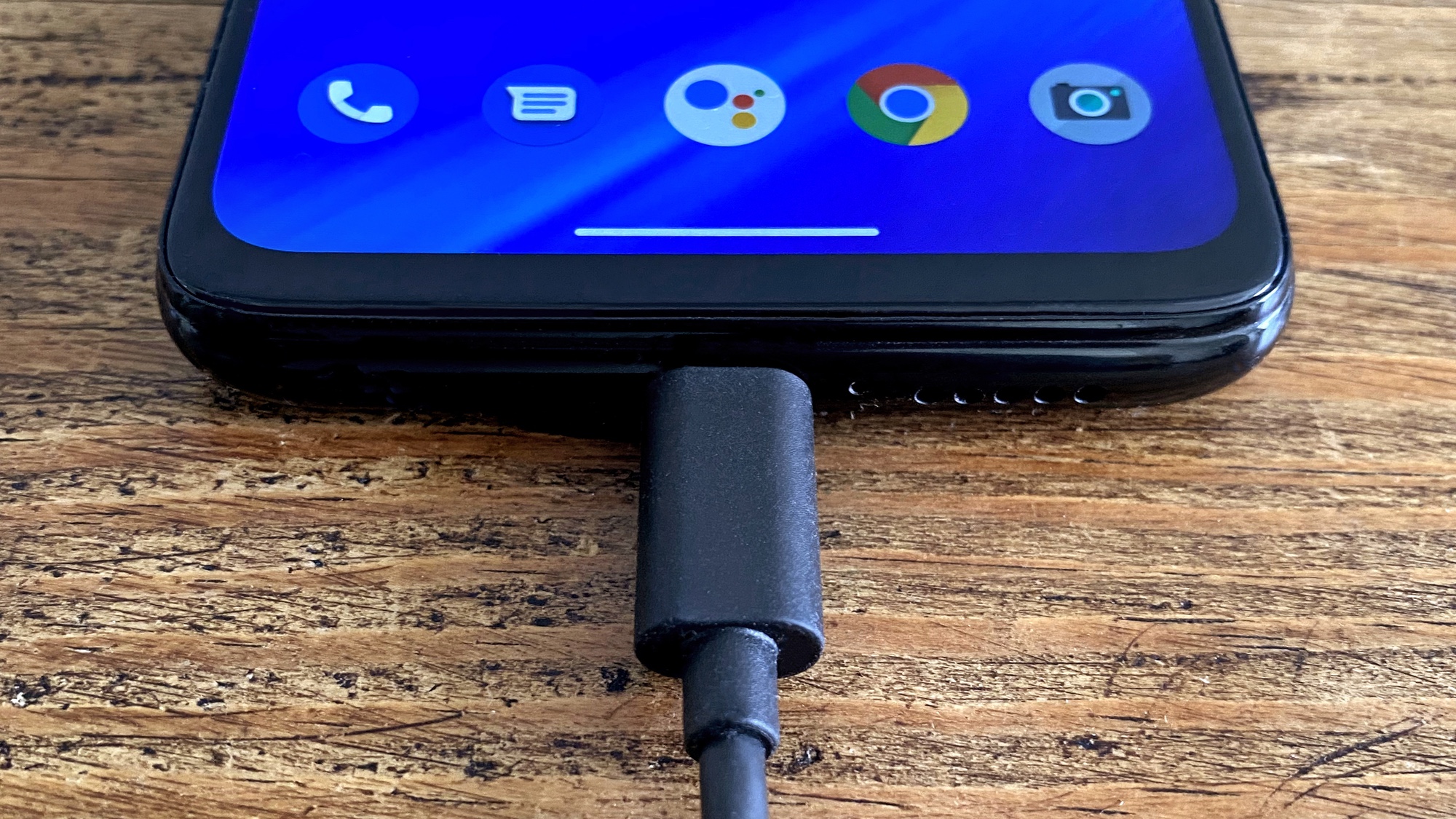
That extra long battery life is good, because when you need to re-charge the Moto G Power, you're going to need to block out some time to fill that 5,000 mAh power pack with the included 10-watt brick. After 15 minutes of charging a drained Moto G Power, I got the phone back to 10% power; that number grew to 21% after half-an-hour. Contrast that with the Pixel 4a, which has a much smaller 3,140 mAh battery to recharge. Yet, its included 18-watt charger gets the job done quicker, getting to half-capacity after 30 minutes.
Moto G Power review: Software and special features
Motorola takes a light hand with the Android skin it puts on its phones, and that thankfully continues with the Moto G Power. You'll find Android 10 on this phone with very little embroidery, save for a prominently displayed Moto app that offers tips and tricks about using your new phone.
If you've not used a Motorola phone before, those tips include your introduction to Moto Actions, which are actually helpful shortcuts for getting the most out of the Moto G Power.
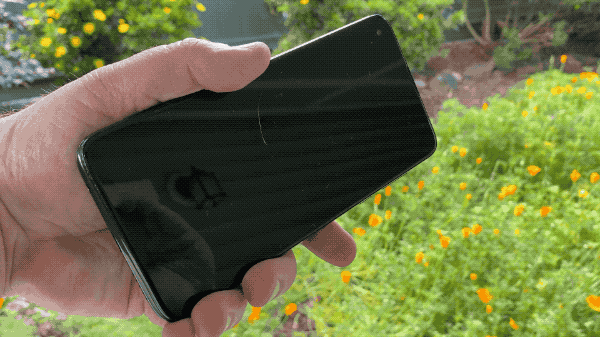
For instance, by quickly twisting your wrist twice, you can launch the camera app, which can be a real time-saver compared to unlocking your phone and launching the camera with a tap. Two chopping motions holding the Moto G Power turns on the phone's flashlight, which I also find helpful. I'm less enamored with Motorola's three-finger touch to take a screenshot.
While the Moto G Power's Fingerprint sensor is easy to locate on the back of the phone, I found it to be less responsive than I normally prefer. It usually took at least two and sometimes three presses of my registered fingerprints for the Moto G Powers sensor to recognize that it was me trying to unlock the phone.
Motorola can be stingy with Android updates. This particular phone is only now getting an update to Android 11, and that's probably it for major Android updates. (You'll still get security patches.) Of course, the Moto G Power (2021) holds no advantage here, as it also shipped with Android 10 and will be done with Android updates once Android 11 is installed.
Moto G Power review: Verdict
Just by retaining the long-lasting battery of the Moto G7 Power, the Moto G Power was already in the conversation for a must-have device for budget-conscious shoppers. But this phone isn't just counting on its longevity to win you over. It also performs well enough to meet the needs of the average smartphone user, and the cameras — while not the best you can find on a budget device — produced some pretty eye-catching shots during our testing for the Moto G Power review.
If you value mobile photography above all, you may want to consider other low-cost options, especially now that the Pixel 4a is here and only $100 more than the Moto G Power. The iPhone SE 2020 is another strong option, with a more premium glass-and-metal design, better cameras and much faster A13 Bionic chip. But you'll need to pay at least $150 more for those mid-range phones than you would for the Moto G Power.
The OnePlus Nord is another budget-minded phone that's fared well in initial battery tests (though nowhere near what the Moto G Power can offer). But that phone is only available in Europe and India at the moment, and the Moto G Power is still likely to cost less should OnePlus decide to bring the Nord to this country.
The biggest competitor to the Moto G Power may be... the Moto G Power. The newer 2021 model didn't last as long on a charge in our testing, but its battery life still impresses and its components are one year newer than the the 2020 edition of the phone we're reviewing here. The Moto G Power remains a compelling option, especially if you can find a discounted price, but if you want the best Motorola has to offer, the Moto G Power 2021 is the better buy at this point.
Philip Michaels is a Managing Editor at Tom's Guide. He's been covering personal technology since 1999 and was in the building when Steve Jobs showed off the iPhone for the first time. He's been evaluating smartphones since that first iPhone debuted in 2007, and he's been following phone carriers and smartphone plans since 2015. He has strong opinions about Apple, the Oakland Athletics, old movies and proper butchery techniques. Follow him at @PhilipMichaels.
-
Harry Baughsak The worst thing about Motorola phones ( I own the 2019 G7 Power) is that Lenovo is ridiculously slow about getting security or OS updates rolled out, especially for the U.S. market. The customer support leaves a lot to be desired as well, mostly consisting of a small shunted-off forum where you can post questions and the forum moderators will mostly dodge the question altogether or link you to a website that has info for every country BUT the U.S. The 5000 mAh battery is all well and good but unless you don't care about security patches and software updates or enjoy constant frustration over the lack of information by Lenovo , I'd take a little less battery life and put your money intoy a Pixel or even a Samsung phone .Reply -
warmon6 "though there’s only 64GB of storage. Need any more, and you have to turn to a microUSB card "Reply
Im assuming you meant MicroSD card? -
Naturelover This is a great phone for a mid size budget phone. I used to have a very small older phone and this runs circles around it. Nice to have big battery and plenty of ram. The gestures are fun and much easier to use. 16 mp rear AND front cameras. Also has wide angle and a macro camera. Its a 6" phone which is not as bad as i thought it would be to hold. Very little bloatware buying from Motorola. Its a brand new phone, so hard to tell on the long run yet, but the 5000 mah battery alone makes this worth $250. To clarify, the g8 power is Euro version only. The US version is just Moto g power. If you look for a case, it will probably say 2020 after it.Reply -
ConanTH Excellent review. Pity it did not mention about reception and call quality. It is a PHONE I believe?Reply -
Warningz I recently purchased the Moto G Power and am disappointed because it is unable to connect to the LTE network on Sprint (just slow 3G). Apparently, this is an old issue plaguing other Moto phones (descirbed here: https://insiderpaper.com/moto-g7-lte-issue-pops-up-after-android-10-update/). I bought the phone partly due to this glowing article and feel a little let down---I would request the author bring down the number of stars until Motorola issues a fix.Reply
